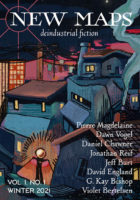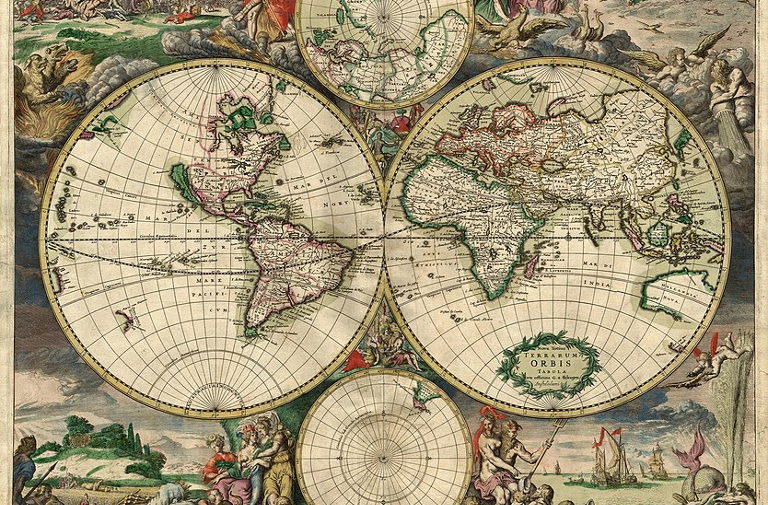 New Maps
New Maps
A quarterly fiction magazine by Looseleaf Publishing
Editor and Designer: Nathanael Bonnell
Website: https://new-maps.com/
First issue: Winter 2021 (released Jan. 17, 2021)
Format: Paperback, 7” x 10”, 96 pp.
Single issue price: $12.00 U.S.; one year subscription (four issues): $42.00.
As its name alludes, this visionary new fiction quarterly seeks to challenge our current mental maps of the future. Its stories will appeal to those who have tired of traditional science fiction, with its self-evidently false assumption that industrial society can forever defy the limits of our finite world. To quote editor Nathanael Bonnell, “[M]any more than before are abandoning the orthodox view of the future to look for futures that ring truer. I hope they can find those here.” The magazine’s first issue delivers nicely on this hope.
New Maps is very good. Its pieces are all superbly written, chosen and arranged. Bonnell’s opening commentary draws brilliant parallels between cartography and storytelling by way of explaining the publication’s title. A scholar of Indigenous ethnography, Bonnell discusses ways in which our society’s representations of space and time differ from those found among the Inuit, Aboriginal Australians, Western Apache of Arizona and other Indigenous cultures. We learn of the fascinating case of the Ammassalik wooden maps. These carved, tactile maps of Greenland’s coastlines, which resemble hand tools more than maps, are not navigational aids but storytelling devices designed to acquaint visitors with the land and its history. To Bonnell, they’re an apt analog for fiction intended to help make sense of the foreign coastline of our deindustrial future.
The tales in issue one are widely varied in tone, theme, narrative style and setting. They include a tender courtship story, a wry comedy, a moving morality play, a harrowing portrait of destitution, a meditation on the fragility of life and even a work of pseudo-anthropological scholarship. Some take place in distant futures, while others are only faintly removed from our time. Some are brief, pointed vignettes; others weave complex yarns. Where they converge is in their portrayal of more grounded, ecologically conscious societies than exist across the developed world today. This grounding is literal: Unlike the characters in so much modern-day sci-fi, who look to outer space as a means of escape from the mess humankind has made for itself on Earth, the characters in these stories are bringing their lifestyles back in line with nature.
The protagonist of Pierre Magdelaine’s “Rhyme and Reason” is an entomologist who says she feels more like a student of dead languages, since most of the species she learned about in school are now gone. She has a particular interest in the great black wasp, an insect considered highly beneficial in our time as both a pollinator and pest controller, but most likely extinct in hers. Citing past examples of species mistakenly thought to have vanished, our scientist maintains a shred of hope for the wasp. When we first meet her, she’s traveling to a town where a farmer believes he’s discovered some of the wasps on his land. The most piercing passage in this poignant tale comes from a rhyme the entomologist sings on her journey. The elegy laments the loss of flowers, honey and songbirds, and closes by imploring, “Give me a reason to carry on/ My love/ In this bland world.”
In “Squatting,” Jeff Burt paints a scenario that is as plausible as it is inconceivable to most people living today. It’s one in which industrial civilization has made no major strides in the direction of either progress or apocalypse, but has instead continued slowly descending the same downward economic slope it’s been on since the mid-1970s. As John Michael Greer is wont to observe, most people would rather face a sudden societal collapse than an indefinite continuation of an ever-worsening economic decline. The future of Burt’s story still has convenience stores, public transport, texting, social media and Medicare—but a comfortable retirement is increasingly out of reach for the elder members of society. The golden years of our two main characters are defined not by golfing, traveling and being with family, but by surreptitiously surfing rent-free from one abandoned property to another.
Jonathan Reif’s “Hot Chips” is a glorious exercise in offbeat comedy, with our opening narrator waxing bitter about how his childhood friend never offered him one of the hot, greasy fries he always devoured during their daily walks together. This fry miser has since become their nation’s minister of finance. In the story’s funniest scene, the now-finance minister reminisces on how he first learned, as a young boy trying to coax money out of his father, to win at negotiation by pouncing when one’s negotiating partner is at his most vulnerable.
Two stories examine the theme of reassessing long-held assumptions about reality. Set in a society bifurcated into village people and desert people, Dawn Vogel’s “Hearts in Motion” tells of a budding romance between two teenagers from opposite sides of the divide. The main character in Daniel Chawner’s “The Inspector’s Legacy” is a by-the-books health inspector who sees his boss committing a flagrant act of fraud, one that later proves to be part of a long-running, benevolent conspiracy to divert food to a nearby starving population.
Perhaps the most sharply realized story is Violet Bertelsen’s “When the Circus Came to Town.” A portrait of the lives of circus performers in a future agrarian society, it rivetingly captures the thrill, danger and tragedy experienced by these itinerant entertainers. Those who value deindustrial fiction as a window into what the technology of the future might look like will find much to enjoy in this story. Its technological landscape is a fascinating mix of natural technologies—from yarrow and calendula honey as antiseptics to pine needle tea as floor cleaner—and revived relics from decades past, such as typewriters.
While most of these stories take place within the next several lifetimes, there are two that prefer to dwell in the distant, wholly unrecognizable future. In David England’s “The Lore of Bread,” polytheism has supplanted monotheism, knowledge is transmitted through oral tradition and the people of our time are likened to “[b]abies who didn’t know any better, an’ in that not-knowin’ did some very bad things.” The speaker in G. Kay Bishop’s “Characters Written in Blood and Milk” is a political prisoner who, by virtue of possessing the uncommon ability to read, has been tasked with interpreting our ancient texts rather than working fields. She and her fellow interpreters are mystified by our habit of writing absolutely everything down, including the most trivial notes to members of one’s household. The above two stories are a delight for those who like their fiction set far in the future with perspectives completely alien to our own.
New Maps welcomes book reviews in addition to stories. In this first issue, Bonnell reviews Ursula K. Le Guin’s 1985 classic Always Coming Home. Bonnell has no shortage of worthwhile things to say about Le Guin’s imaginative and immersive study of a fictional matriarchal people called the Kesh, who inhabit a future deindustrial version of northern California. Above all, he rightly lauds it for pioneering the deindustrial fiction genre. Years before the aforementioned John Michael Greer, a fellow trailblazer in the realm of deindustrial storytelling, began incorporating the theme of technological bricolage into his fiction, Le Guin explored it in her work. Just as in Greer’s fictional worlds, the technological landscape of the Kesh spans the gamut of human history, from hunter-gatherer times to the computer era. It thus rebuts the modern-day superstition that one can’t pick and choose from given technological regimes, but must either accept or reject them wholesale.
The letters to the editor brim with story ideas. One voices a desire for tales from a post-globalist and late-industrial-age future that deal with “cultural differences in attitudes on electricity between countries, regions, even perhaps urban-rural differences.” Another calls on people to think of new approaches to waste-stream salvage and the preservation of traditional skills that can be applied in today’s world. It is with the utmost excitement that I look forward to these suggestions being taken up in future issues.
Teaser photo credit: By en:Gerard van Schagen – This image is made up of six separate images downloaded from Helmink.com and stitched together., Public Domain, https://commons.wikimedia.org/w/index.php?curid=1417142






